During my Lemco tenure as the director of training, we ran more than 500 managers through our Management Development Programs (MDPs). Each course was either nine or 12 months long, depending on the department in training. Was there nine months of information to inject into the candidate? No, but we wanted to see the results of the small changes in between meetings, utilizing a departmental composite as the scorecard.
The composite only contained things the department manager could control in the numbers such as departmental profitability, staffing expenses and any direct expenses to the department. What it didn’t contain were allocations for things like rent, insurance, administration costs, etc. The composite wasn’t a profit and loss (P&L) statement. It was never designed to mirror a P&L statement. It was designed to be a manager’s report and should only contain data that the manager could control. When a manager cannot effect the change, yet is being held accountable for the result, he takes no ownership of the outcome. For a scorecard to be effective, it must be controllable by the individual. Including items like rent into a manager’s scorecard and then expecting him to “own” the result is the equivalent of putting a service scorecard in the sales manager’s office and expecting the sales manager to affect the productivity percentages. However, stripping uncontrollable expenses out of the scorecard leaves a manager with only his results. At that point, he owns it — the good and the bad. Managers suddenly realize that very small changes in behavior on the floor net them a big impact in departmental contribution.
A (non-HD) sales department should contribute 12 percent of every dollar brought into the department to overall store profitability. During the MDPs, we’d have guys sitting at, and comfortable with, a 10 percent contribution. The department would be dissected and opportunities were found in pay-plans, traffic logs, staffing, etc. When pressed to make these changes, many managers dismissed the headroom, as they were content running as is. I asked a sales manager once, “If you really worked on this, don’t you think you could find a way to attain one more point in gross profit? And if you really had to, couldn’t you find a way to trim the expenses just one point (he was only two points away from the goal)?” The sales manager responded, “Honestly, what you’re suggesting is a ton of work. Why would I incur twice as much work for myself for only 2 percent more to the bottom line?”
As I looked around the room, I realized that he, and many others, actually believed that it was only 2 percent more revenue. Increasing from 10 percent contribution to 12 percent isn’t actually 2 percent; it’s 20 percent. The question should be, “Is it worth the extra work for 20 percent more revenue?”
Skeptics: keep reading, even if you don’t believe that I can compute simple math.
Most managers don’t get the example above, as their scorecards are inclusive of too many things outside of their control. When the manager can control it, small tweaks all flow down to the bottom line. It’s a concept called gross is net (G=N).
Let me spell it out for you: My truck holds seven quarts of oil. Let’s assume I didn’t know that. Without knowing that my truck only takes seven quarts of oil, I proceed to crack open an eighth quart to refill my truck during an oil change. I tip it into the funnel and walk into the house to let it drain. When I come back out to my truck, how much oil is now on the floor of the garage? The answer is 100 percent of anything over the seventh quart, or simply one quart.
Now let’s bring this into the dealership. Every month, there are necessary expenses to keep the department profitable (flooring, payroll, etc). At some point during the month, the expenses for that department have been paid. Once paid, how much new inbound revenue now flows to the bottom line? The answer is all of it. One hundred percent of the overage flows to the bottom line, and gross dollars become net dollars. Most dealerships cover the expenses somewhere around the 26th day of the month, leaving four days of G=N actualization. What happens if the manager, through controllable measures, can get his department to that actualization date one day sooner? One day is 25 percent of four, so that’s an increase of 25 percent to the bottom line. I ask again, “Is it worth it?”
When the manager can begin to recognize the massive effects of the small changes made in his department, he becomes addicted to finding the next change. However, when accountability measures are watered down with store expenses that have nothing to do with the manager, ownership of the department is never attained and average performance continues.
Sam was brought on board to Lemco as a sales and F&I trainer in 2000, where he quickly became the director of training and ultimately became a partner in the buyout of 2005. He went solo in early 2009 and now moderates seven 20-Clubs, and also consults and conducts in-dealership training. He continues to do contract work with a number of OEMs as well.













